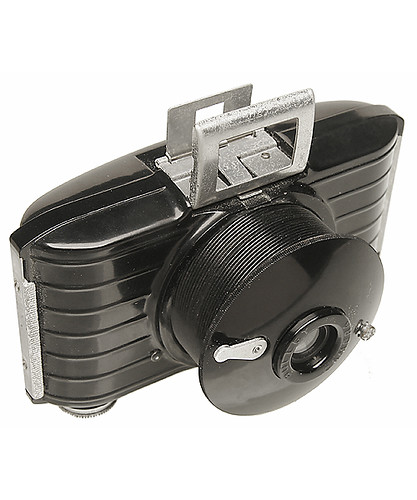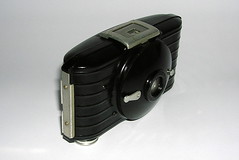Difference between revisions of "Kodak Bullet"
Hanskerensky (talk | contribs) m (Now Category:B|Bullet Kodak) |
Hanskerensky (talk | contribs) (→Links: Redirected Link URL to new site) |
||
| Line 25: | Line 25: | ||
{{brl}} | {{brl}} | ||
== Links == | == Links == | ||
| − | * [ | + | * [https://patents.google.com/patent/USD103700S/en?oq=D103700 Bullet design patent USD103700S] by Walter Dorwin Teague |
* [http://en.wikipedia.org/wiki/Art_deco Wikipedia: Art Déco] | * [http://en.wikipedia.org/wiki/Art_deco Wikipedia: Art Déco] | ||
* [http://en.wikipedia.org/wiki/Walter_Dorwin_Teague Wikipedia: Walter Dorwin Teague] | * [http://en.wikipedia.org/wiki/Walter_Dorwin_Teague Wikipedia: Walter Dorwin Teague] | ||
Latest revision as of 06:12, 12 June 2022

|
| Kodak Bullet image by Rick Soloway (Image rights) |
This small 127 (4 × 6 1/2 cm) camera from 1936 is a fine example of the Art Deco design motifs of the era. It is part of a family of Kodak models styled by Walter Dorwin Teague, together with the Kodak Baby Brownie and Kodak Bantam.
The design of the Bakelite Kodak Bullet is very simple. A helicoid lens barrel can retract into the body; the shutter release lever sits alongside the simple meniscus lens. To change the film, the entire back is removed. Two versions exist: one with a sliding catch on one side and a corresponding (but not functional) catch-bar on the other; the second version omits this decorative bar. There was also a version marked "New York World’s Fair" made in 1939.
The Bullet name was reused later, as the Brownie Bullet.

|
| Kodak Bullet, closed image by jgs4309976 (Image rights) |
Links
- Bullet design patent USD103700S by Walter Dorwin Teague
- Wikipedia: Art Déco
- Wikipedia: Walter Dorwin Teague